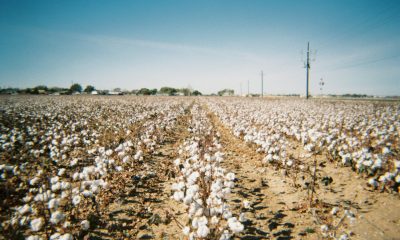Featured
Rice Closed Higher Last Week and Closed at New Highs for the Move
USDA left its ending stocks estimate unchanged for the current crop year and for the next crop year despite a rebound in rice production for the next crop. Ending stocks were estimated at 16.8 million cwt for both crop years. Rice production for the current year was unchanged at 128.2 million cwt and higher for the coming year at 142.0 million cwt.

Wheat: Wheat markets were mostly higher, with Kansas City leading the way and Minneapolis trading higher. Chicago SRW futures were lower. The moves came in part in reaction to the USDA production estimates released on Friday. Soft Red Winter production was estimated 21% higher than a year ago at 406 million bushels. Hard Red Winter production was down 3% at 514 million bushels and White production was estimated 11% lower at 210 million bushels. USDA also cut demand so ending stocks estimates were 266.3 million bushels for the current crop and 264.3 million for the next crop. Planting of Spring Wheat has been delayed due to wet soils from melting snow and now from reports of dry weather in western production areas of both the US and Canada. Dry conditions are a developing problem in Russia, and especially in the Spring Wheat areas there. Uncertainty about the Black Sea Corridor deal continued. Russia has said that the current system cannot last and seems ready to kill the deal completely. Ideas that big Russian offers and cheaper Russian prices would be a feature for a while in the world market were the driving force for the weaker prices. Ideas are that both Australia and Russia are harvesting record to near-record Wheat crops this year.
Weekly Chicago Soft Red Winter Wheat Futures
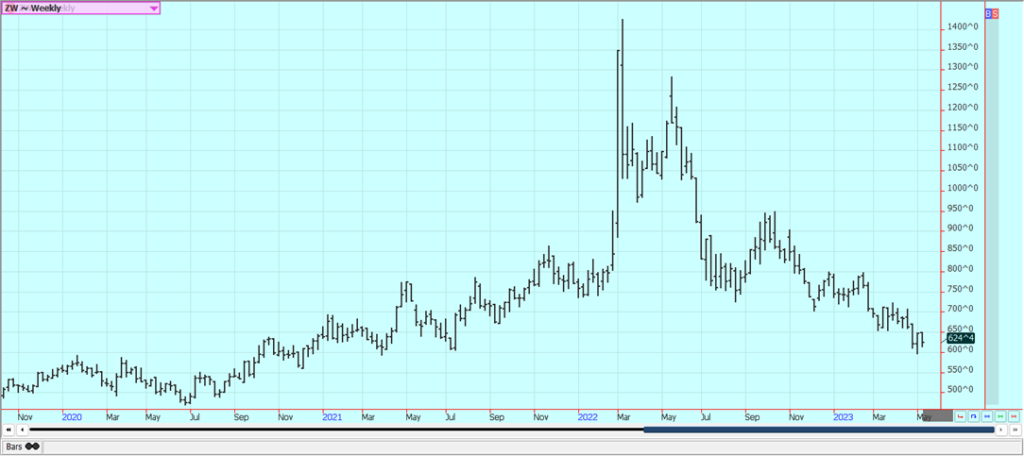
Weekly Chicago Hard Red Winter Wheat Futures
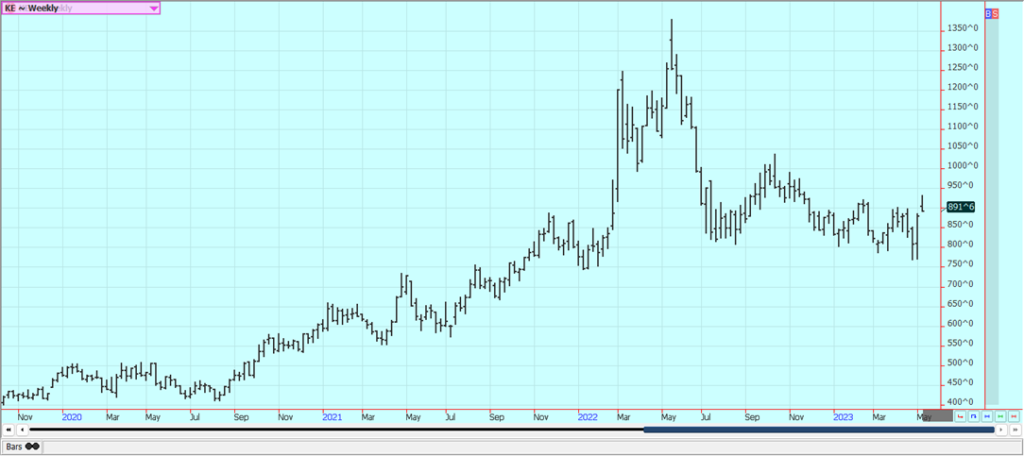
Weekly Minneapolis Hard Red Spring Wheat Futures
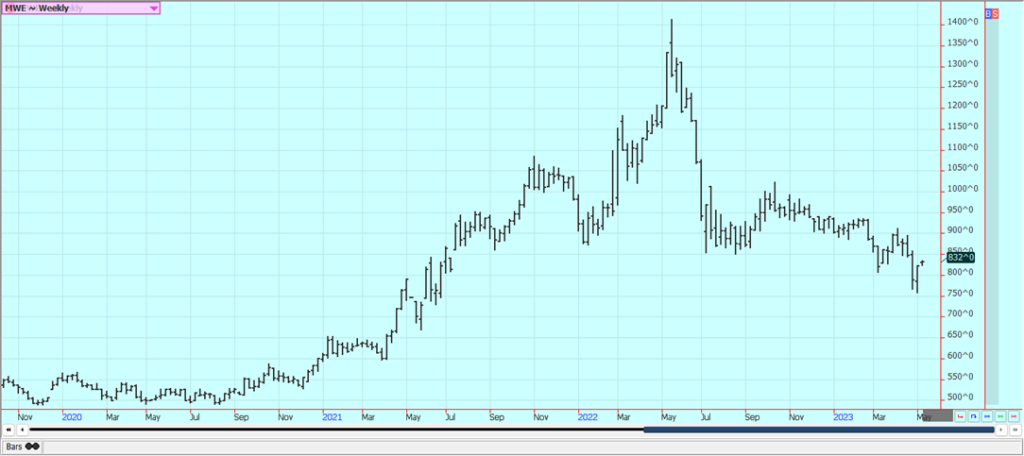
Corn: Corn closed lower last week and Oats closed higher, with Corn hurt by ideas of weak demand. The weekly export sales report showed poor demand. USDA’s ending stocks estimates were higher and above trade expectations at 1.417 billion bushels for the current crop and 2.222 billion for the new crop. New crop production was estimated above trade expectations at 15.265 billion bushels due to strong yield potential and expanded planted area. Reports of strong planting progress and less Chinese demand hurt the Corn price action. Corn is still finding some support from little US producer selling interest. Most producers are in the fields and are not even worried about the market. Warmer and drier weather for good planting is expected for the rest of this week, but showers are possible again this weekend. US prices are currently very competitive with those from South America as Brazil concentrates on Soybeans exports and not Corn and US demand has improved because of the price differentials and the lack of a Brazil offer into the market. This trend should continue for the next few months. NOAA is forecasting that La Nina will develop this Summer and replace El Nino. US growing conditions are usually good when this happens but there are concerns about ocean water temperatures that are increasing rapidly in the Pacific and have alarmed some forecasters.
Weekly Corn Futures
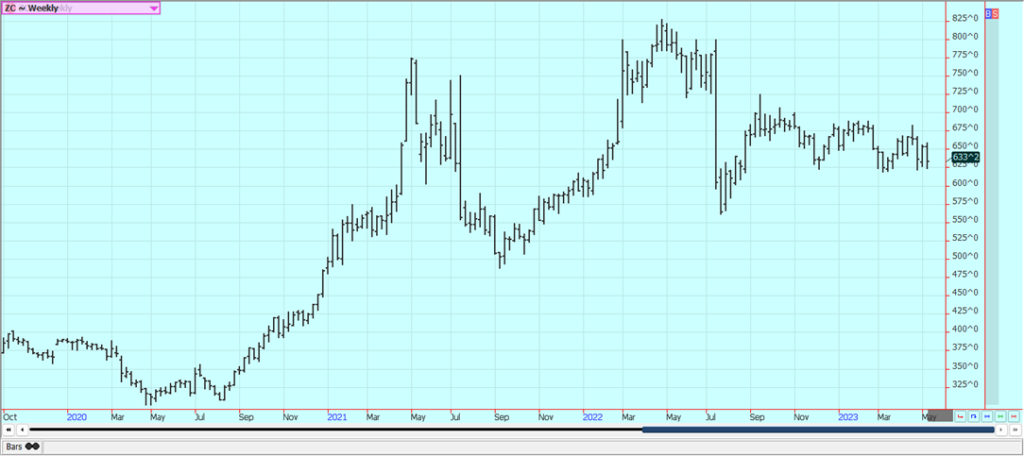
Weekly Oats Futures

Soybeans and Soybean Meal: Soybeans and the products were lower last week, with selling on Friday seen n response to the latest USDA WASDE reports. USDA estimated the new crop production at 4.510 billion bushels against expectations of production near 4.485 billion. Ending stocks for the current crop year were estimated at 215 million bushels and ending stocks for the coming year were estimated at 3.335 million. Brazil production went up a million tons to 155 million but Argentine production was left unchanged at 27 million. The weekly export sales report showed bad demand for Soybeans and Soybean Oil and good demand for Soybean Meal. Brazil basis levels are still so low that some American processors can import more cheaply than buying from US producers. Reports last week indicated that the basis is forming in Brazil, but prices for Brazil Soybeans remain cheap compared to those found in the US. Brazil has been selling a lot of Soybeans to China to feed its Soybeans demand, but Chinese customs is now making delivery of the beans very difficult by delaying entry into the country by about two weeks. Brazil has a very good crop, but the additional Soybeans grown in Brazil will be partially wiped out by the losses in Argentina. Argentina has been forced to import from Brazil to keeps its crushing facilities operating. Forecasts from NOAA for very good growing conditions in the Midwest were also a factor, but there are concerns about ocean water temperatures that are increasing rapidly in the Pacific and have alarmed some forecasters.
Weekly Chicago Soybeans Futures
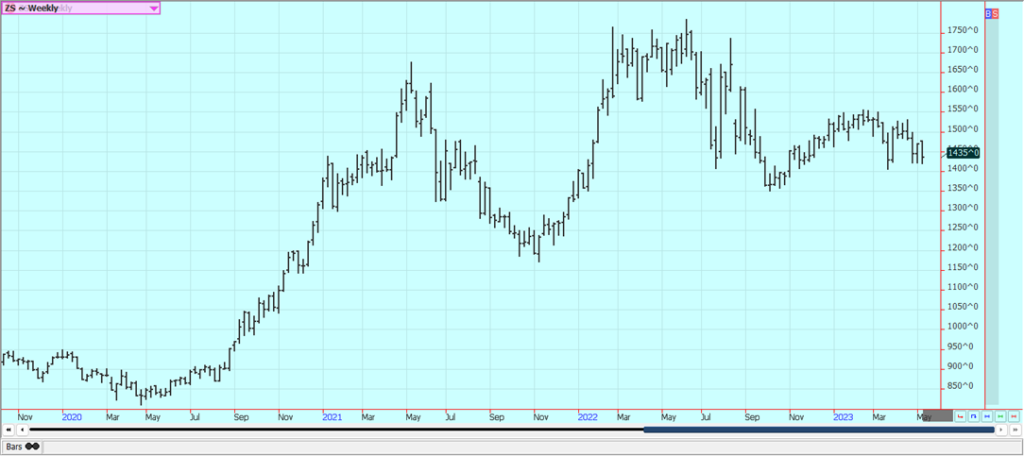
Weekly Chicago Soybean Meal Futures
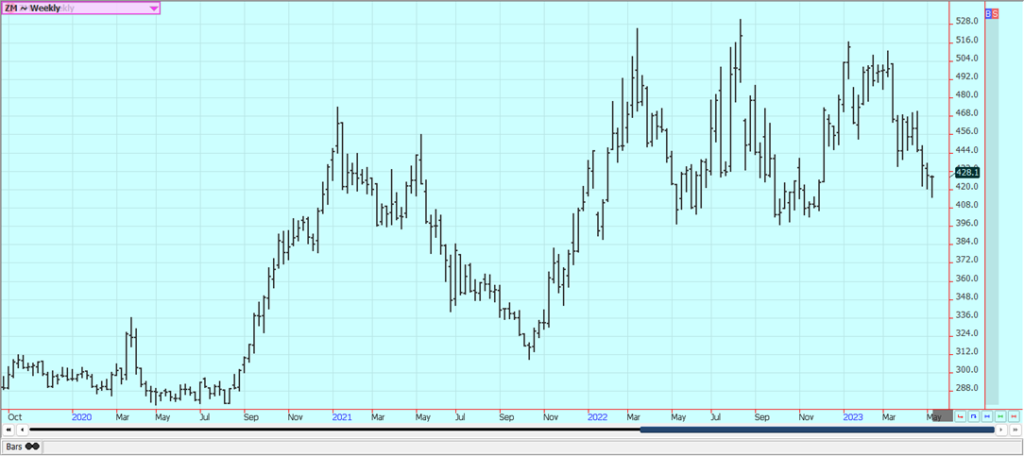
Rice: Rice closed higher last week and closed at new highs for the move. USDA left its ending stocks estimate unchanged for the current crop year and also for the next crop year despite a rebound in production for the next crop. Ending stocks were estimated at 16.8 million cwt for both crop years. Production for the current year was unchanged at 128.2 million cwt and higher for the coming year at 142.0 million cwt. Domestic and export demand were higher for next year to take care of the increased production. The weekly export sales report showed average sales volumes. Traders were getting ready for the WASDE report to be released later today. Offers still seem hard to find right now, but demand has been a problem all year. Export demand has been uneven and was low last week. Export demand has been an issue for the market all year. Mills are milling for the domestic market in Arkansas and are bidding for some Rice, but at l4east some mills say they now have enough bought to last until the harvest of the next crop.
Weekly Chicago Rice Futures

Palm Oil and Vegetable Oils: Palm Oil was lower last week on Chicago price action and on ideas of reduced supplies and production. The rebound did not happen in April as production was 7% less than March at 1.196 million tons. Exports were also down and ending stocks were estimated at 1.597 million tons, down over 10% from last month. The report was expected to support Palm Oil futures at this time. Trends are still sideways on the weekly charts and are now sideways on the daily charts. Canola was lower last week along with the price action in Chicago. Trends are mixed on the weekly charts. Brazil is expected to dominate the oilseeds market for the next few months. Reports indicate that domestic demand has been strong due to favorable crush margins. It is very dry in the Canadian Prairies, and especially in western sections. Producers want to plant but are hoping for some moisture. Only isolated showers are in the forecast.
Weekly Malaysian Palm Oil Futures
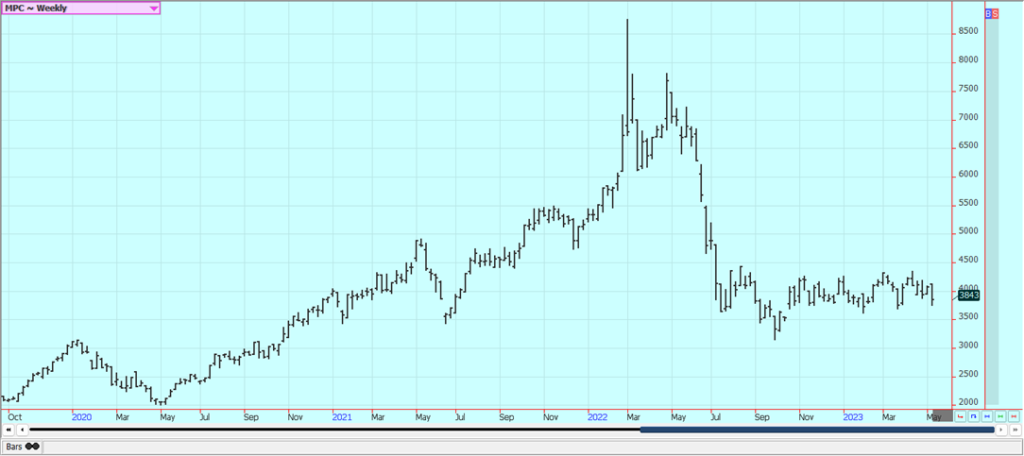
Weekly Chicago Soybean Oil Futures
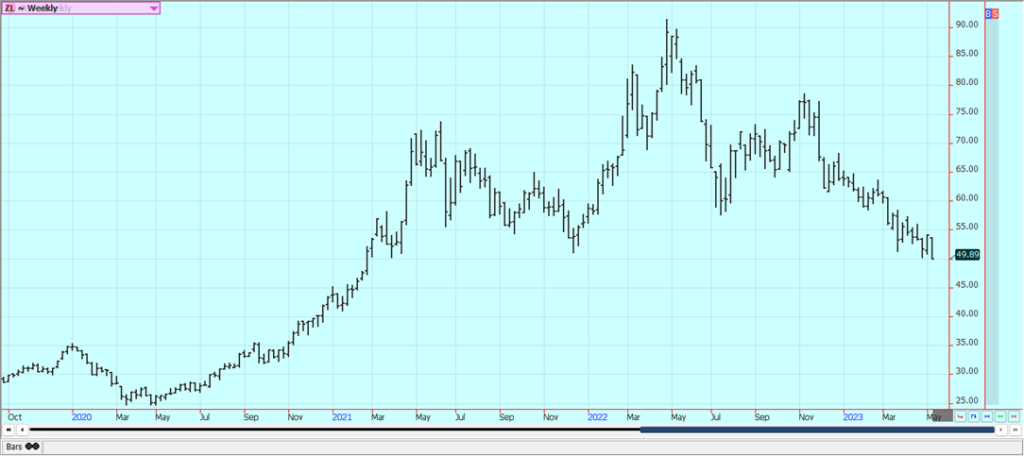
Weekly Canola Futures:
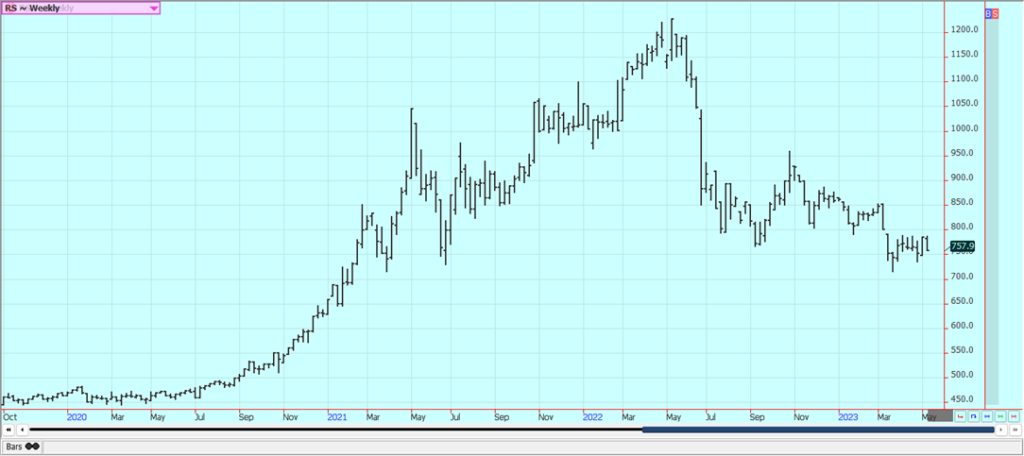
Cotton: Cotton was lower last week, but rebounded on Friday on the back of the latest USDA production and WASDE reports. USDA said final production for the current year was 14.68 million bales. It estimated current year ending stocks at 3.5 million bales. USDA estimate production next year at 15.5 million bales and total supply at just over 19 million bales. Total use was estimated at 15.7 million bales so ending stocks are estimated to be 3.3 million bales at the end of the next crop year. USDA showed the potential for a tight supply and demand situation looking forward. Traders were adjusting positions before the WASDE report today. Demand has been good, but the market is starting to shift attention to the new crop. Planting intentions showed only weak production ideas, but demand has been less until reviving lately. Forecasts for rain are still showing in forecasts for West Texas but the rains are expected to be lighter and more scattered than last week. The rains last week were spotty so more rain in new areas would be very beneficial. The rains will not solve drought problems but at least producers in the region can get started on fieldwork and hope for better yields this year. Ideas are that the world economic problems were fading into the background as the US stock market has held strong and as the Chinese economy gets better after all of the Covid lockdowns.
Weekly US Cotton Futures

Frozen Concentrated Orange Juice and Citrus: FCOJ closed lower last week and featured selling in response to the USDQ production estimates released on Friday. USDA estimated production down at 15.7 million boxes for Florida. The market response implies that the lower production is already factored into the price. Trends are down in this market despite very tight supplies as there has not been any news to keep bulls in the market lately. Futures remain supported by very short Oranges production estimates for Florida. Demand is thought to be backing away from FCOJ with prices as high as they are currently, but the market has not taken any note and continues to charge higher. Historically low estimates of production due in part to the hurricanes and in part to the greening disease that have hurt production, but conditions are significantly better now with scattered showers and moderate temperatures. The weather remains generally good for production around the world for the next crop including production areas in Florida that have been impacted in a big way by the two storms seen previously in the state. Brazil has some rain and conditions are rated good. Florida Citrus Mutual said that FCOJ inventories are 33% less than last year.
Weekly FCOJ Futures
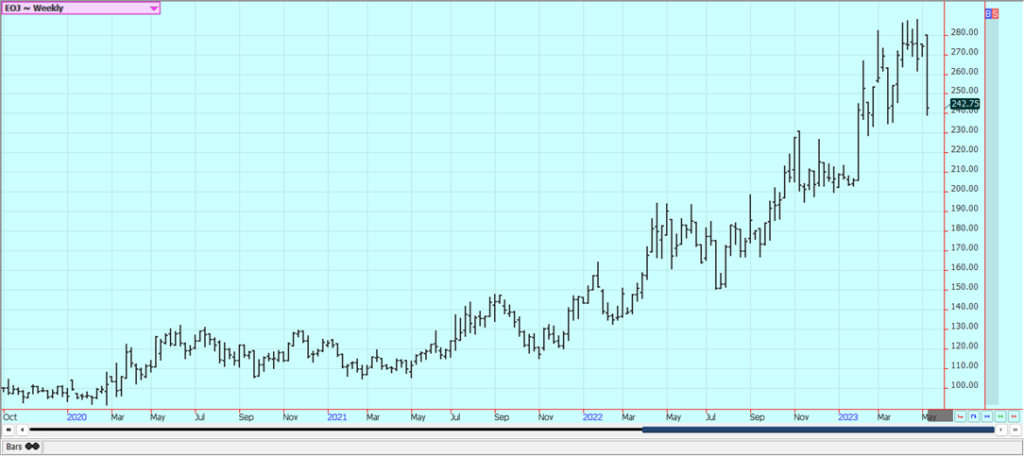
Coffee: New York was a little lower, and London was higher in range trading on Friday, but both markets closed a little lower for the week. There are reports of increased offers of Robusta from Brazil, and good weather is noted for Arabica production there, with high production expectations for Brazil. The Arabica harvest is now just a few weeks away and offers of Arabica from Brazil are expected to increase at that time. Charts trends are sideways on the daily charts. There are still tight Robusta supplies for the market amid strong demand for Robusta, but the Brazil harvest is in the market now. The Brazil harvest of Robusta is in full swing and promising to help relieve tight supplies in that market. The Arabica harvest should be active in the next few weeks. The Robusta market has been especially tight and has been pushing on the Arabica price, but Arabica supplies are growing tight in the market as well. Producers in Vietnam are said to have almost nothing left to sell and producers in Colombia and Brazil are also reported to be short Coffee to sell. The market really needs big offers from Brazil to sustain any down side movement. Brazil said that April exports were 14% less than a year ago at 2.7 million bags. Exports of both Arabica and Robusta beans were less than a year ago, but exports of roasted, ground, and soluble coffee were higher than a year ago.
Weekly New York Arabica Coffee Futures

Weekly London Robusta Coffee Futures
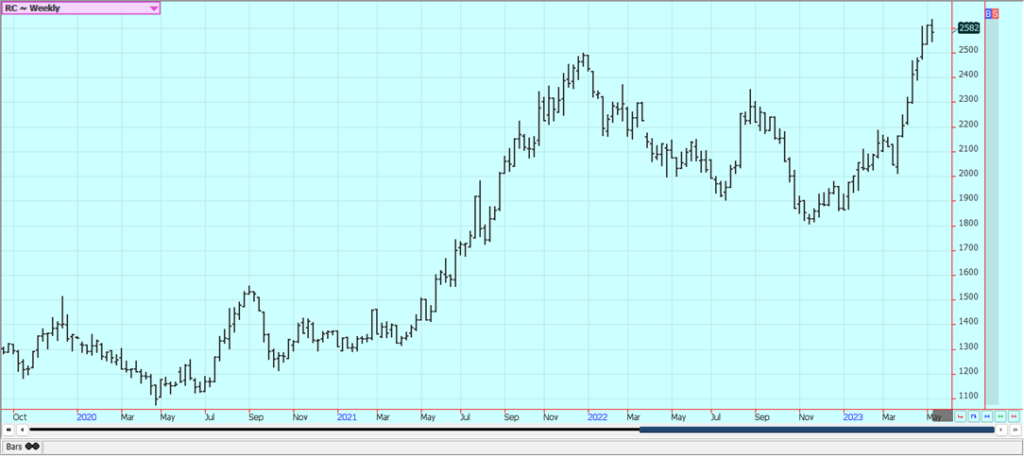
Sugar: Both New York and London closed slightly lower last week, and trends remain sideways in both markets. The market was hurt by good growing conditions in Brazil but supported by tight current supplies. Concern was noted about Chinese demand and the Brazil harvest is now just a few weeks away. Chinese demand has been a mystery as no one knows how much they will eventually buy. The production is not there to meet the demand in many countries, with only Brazil among the major producers looking to have a good crop. It should start becoming available soon. Indian production is less this year as mills are closing early there and Pakistan also has reduced production. Thailand mills are also closing earlier than expected so the crop there might be less. Asian countries could face another year of short production as El Nino returns after years of La Nina. European production is expected to be reduced again this year. Chinese production could be the lowest in six years due to bad growing conditions. Brazil said that center-south Sugarcane processing was 21 million tons this year, down 13% from last year as fields to be harvested got too much rain. Sugar production was 988,970 tons, up 5.9% from last year, and ethanol production was 978 million liters, down 11% from last year.
Weekly New York World Raw Sugar Futures
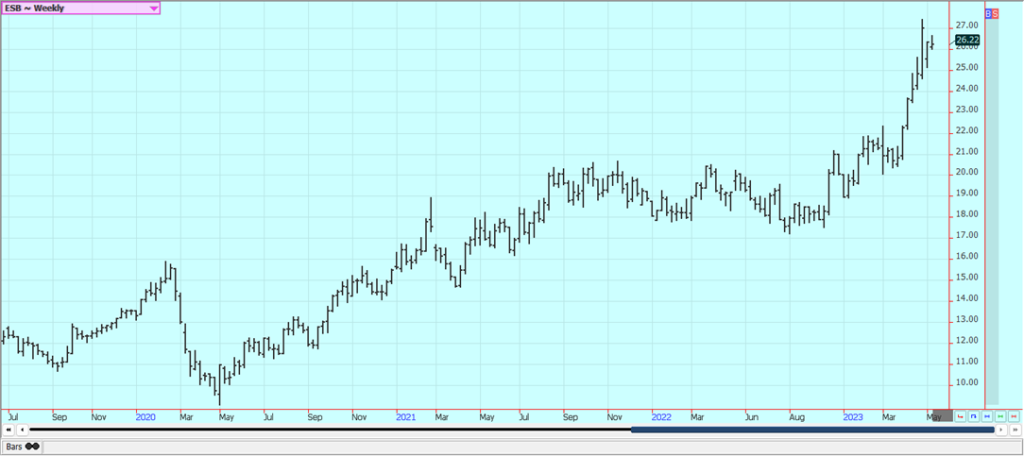
Weekly London White Sugar Futures
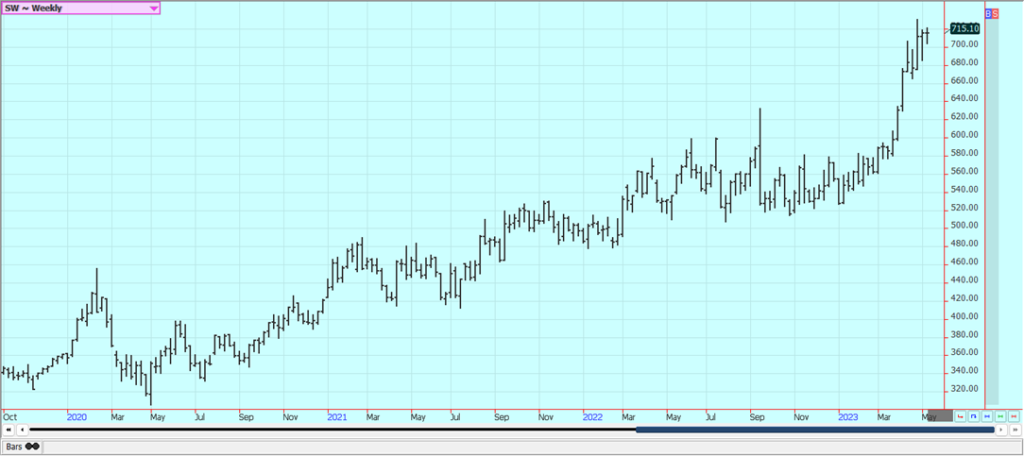
Cocoa: New York and London closed higher again last week as ideas of tight supplies based on more reports of reduced arrivals in Ivory Coast continue. The lack of arrivals from West Africa to ports is still important and is supporting futures, but certified stocks have increased a lot this week in New York and deliveries have picked up as well. Talk is that hot and dry conditions reported earlier in Ivory Coast could curtail main crop production, and main crop production ideas are not strong. Midcrop production ideas are strong due to rain mixed with some sun recently reported in Cocoa areas of the country
Weekly New York Cocoa Futures

Weekly London Cocoa Futures
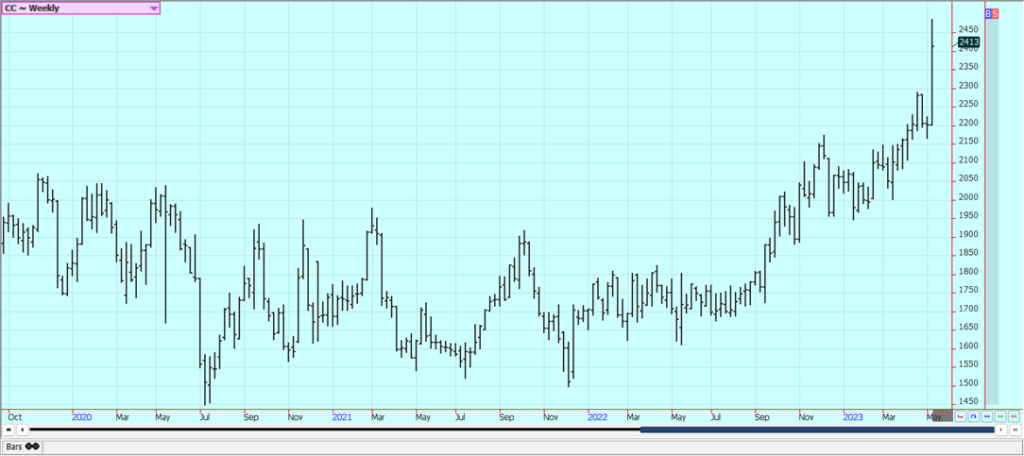
__
(Featured image by almatel via Pixabay)
DISCLAIMER: This article was written by a third-party contributor and does not reflect the opinion of Born2Invest, its management, staff, or its associates. Please review our disclaimer for more information.
This article may include forward-looking statements. These forward-looking statements generally are identified by the words “believe,” “project,” “estimate,” “become,” “plan,” “will,” and similar expressions. These forward-looking statements involve known and unknown risks as well as uncertainties, including those discussed in the following cautionary statements and elsewhere in this article and on this site. Although the Company may believe that its expectations are based on reasonable assumptions, the actual results that the Company may achieve may differ materially from any forward-looking statements, which reflect the opinions of the management of the Company only as of the date hereof. Additionally, please make sure to read these important disclosures.
Futures and options trading involves substantial risk of loss and may not be suitable for everyone. The valuation of futures and options may fluctuate and as a result, clients may lose more than their original investment. In no event should the content of this website be construed as an express or implied promise, guarantee, or implication by or from The PRICE Futures Group, Inc. that you will profit or that losses can or will be limited whatsoever. Past performance is not indicative of future results. Information provided on this report is intended solely for informative purpose and is obtained from sources believed to be reliable. No guarantee of any kind is implied or possible where projections of future conditions are attempted. The leverage created by trading on margin can work against you as well as for you, and losses can exceed your entire investment. Before opening an account and trading, you should seek advice from your advisors as appropriate to ensure that you understand the risks and can withstand the losses.

-

 Crowdfunding1 week ago
Crowdfunding1 week agoPMG Empowers Italian SMEs with Performance Marketing and Investor-Friendly Crowdfunding
-

 Markets5 days ago
Markets5 days agoMarkets Wobble After Highs as Tariffs Rise and Commodities Soar
-

 Markets2 weeks ago
Markets2 weeks agoThe Big Beautiful Bill: Market Highs Mask Debt and Divergence
-

 Africa2 days ago
Africa2 days agoORA Technologies Secures $7.5M from Local Investors, Boosting Morocco’s Tech Independence







